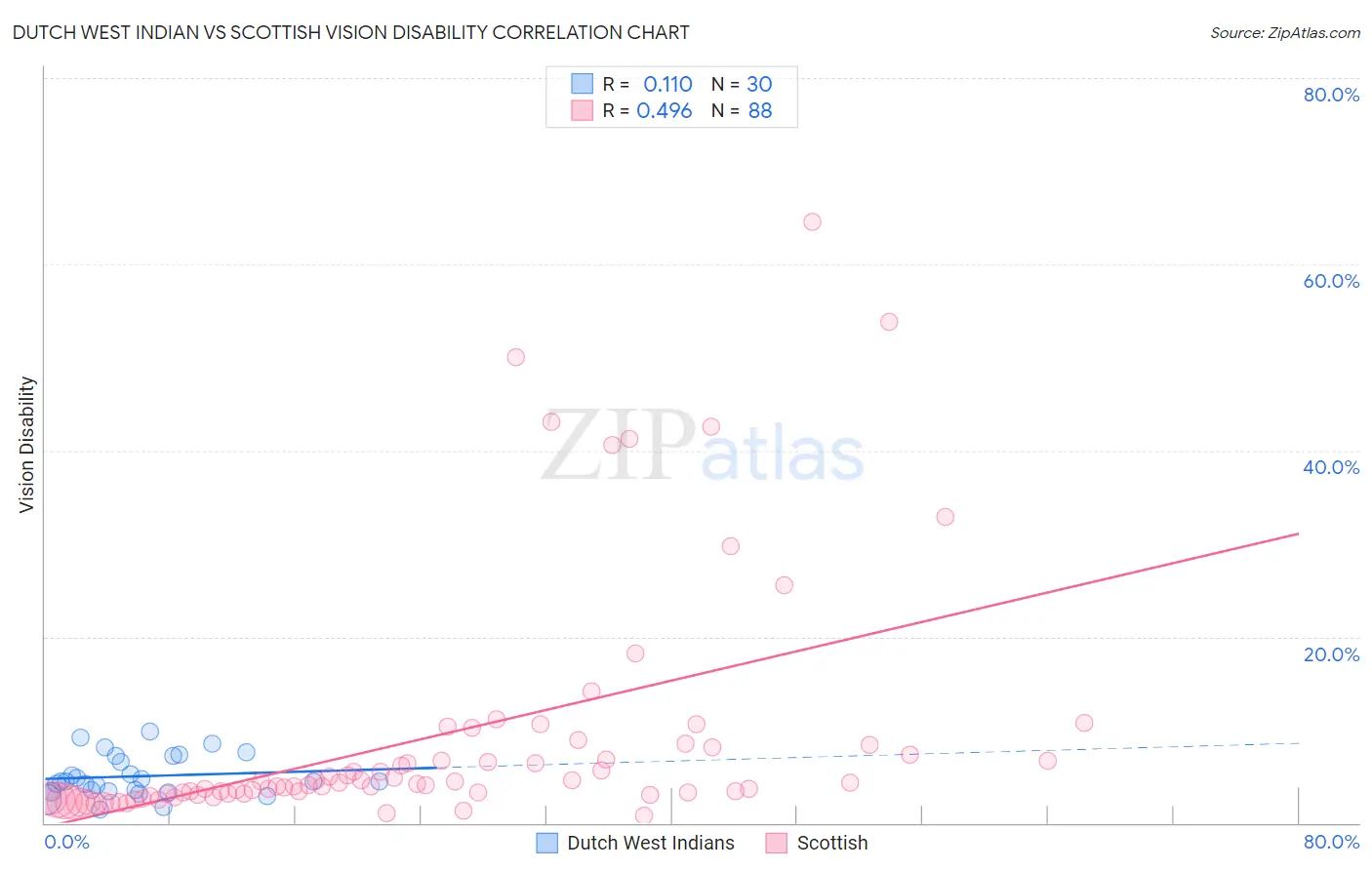Dutch West Indian vs Scottish Vision Disability
COMPARE
Dutch West Indian
Scottish
Vision Disability
Vision Disability Comparison
Dutch West Indians
Scottish
3.2%
VISION DISABILITY
0.0/ 100
METRIC RATING
337th/ 347
METRIC RANK
2.3%
VISION DISABILITY
1.6/ 100
METRIC RATING
234th/ 347
METRIC RANK
Dutch West Indian vs Scottish Vision Disability Correlation Chart
The statistical analysis conducted on geographies consisting of 85,756,307 people shows a poor positive correlation between the proportion of Dutch West Indians and percentage of population with vision disability in the United States with a correlation coefficient (R) of 0.110 and weighted average of 3.2%. Similarly, the statistical analysis conducted on geographies consisting of 565,142,315 people shows a moderate positive correlation between the proportion of Scottish and percentage of population with vision disability in the United States with a correlation coefficient (R) of 0.496 and weighted average of 2.3%, a difference of 36.5%.

Vision Disability Correlation Summary
| Measurement | Dutch West Indian | Scottish |
| Minimum | 1.5% | 0.83% |
| Maximum | 9.9% | 64.6% |
| Range | 8.4% | 63.8% |
| Mean | 5.0% | 9.1% |
| Median | 4.5% | 4.1% |
| Interquartile 25% (IQ1) | 3.4% | 3.0% |
| Interquartile 75% (IQ3) | 7.2% | 7.7% |
| Interquartile Range (IQR) | 3.8% | 4.7% |
| Standard Deviation (Sample) | 2.2% | 12.9% |
| Standard Deviation (Population) | 2.2% | 12.8% |
Similar Demographics by Vision Disability
Demographics Similar to Dutch West Indians by Vision Disability
In terms of vision disability, the demographic groups most similar to Dutch West Indians are Alaskan Athabascan (3.1%, a difference of 0.030%), Navajo (3.1%, a difference of 0.19%), Chickasaw (3.2%, a difference of 0.91%), Tsimshian (3.2%, a difference of 1.6%), and Creek (3.2%, a difference of 1.7%).
| Demographics | Rating | Rank | Vision Disability |
| Colville | 0.0 /100 | #330 | Tragic 3.0% |
| Central American Indians | 0.0 /100 | #331 | Tragic 3.0% |
| Seminole | 0.0 /100 | #332 | Tragic 3.1% |
| Cajuns | 0.0 /100 | #333 | Tragic 3.1% |
| Cheyenne | 0.0 /100 | #334 | Tragic 3.1% |
| Navajo | 0.0 /100 | #335 | Tragic 3.1% |
| Alaskan Athabascans | 0.0 /100 | #336 | Tragic 3.1% |
| Dutch West Indians | 0.0 /100 | #337 | Tragic 3.2% |
| Chickasaw | 0.0 /100 | #338 | Tragic 3.2% |
| Tsimshian | 0.0 /100 | #339 | Tragic 3.2% |
| Creek | 0.0 /100 | #340 | Tragic 3.2% |
| Kiowa | 0.0 /100 | #341 | Tragic 3.3% |
| Choctaw | 0.0 /100 | #342 | Tragic 3.3% |
| Pima | 0.0 /100 | #343 | Tragic 3.3% |
| Pueblo | 0.0 /100 | #344 | Tragic 3.3% |
Demographics Similar to Scottish by Vision Disability
In terms of vision disability, the demographic groups most similar to Scottish are Marshallese (2.3%, a difference of 0.070%), Immigrants from Congo (2.3%, a difference of 0.16%), Central American (2.3%, a difference of 0.18%), German Russian (2.3%, a difference of 0.20%), and Immigrants from Portugal (2.3%, a difference of 0.21%).
| Demographics | Rating | Rank | Vision Disability |
| Hawaiians | 2.9 /100 | #227 | Tragic 2.3% |
| Hmong | 2.5 /100 | #228 | Tragic 2.3% |
| Welsh | 2.3 /100 | #229 | Tragic 2.3% |
| Nicaraguans | 2.2 /100 | #230 | Tragic 2.3% |
| Immigrants | Ecuador | 2.0 /100 | #231 | Tragic 2.3% |
| German Russians | 1.8 /100 | #232 | Tragic 2.3% |
| Central Americans | 1.8 /100 | #233 | Tragic 2.3% |
| Scottish | 1.6 /100 | #234 | Tragic 2.3% |
| Marshallese | 1.5 /100 | #235 | Tragic 2.3% |
| Immigrants | Congo | 1.4 /100 | #236 | Tragic 2.3% |
| Immigrants | Portugal | 1.4 /100 | #237 | Tragic 2.3% |
| Immigrants | Cambodia | 1.1 /100 | #238 | Tragic 2.3% |
| English | 1.1 /100 | #239 | Tragic 2.3% |
| Panamanians | 0.9 /100 | #240 | Tragic 2.3% |
| Malaysians | 0.9 /100 | #241 | Tragic 2.3% |